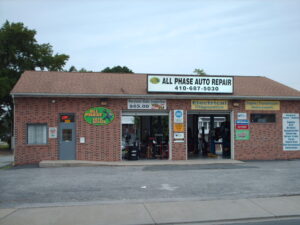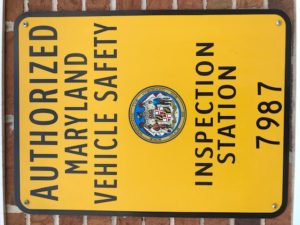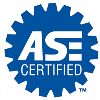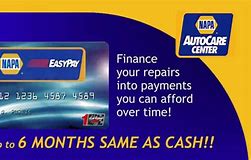“Prepaid Visa Card”
 CFNA Credit Card users receive money back when spending $500 the whole month of April.
CFNA Credit Card users receive money back when spending $500 the whole month of April.
State Inspections, Emissions Repairs, Engine Diagnostics, Maintenance.
Posted in: Uncategorized
Leave a Comment (0) →Author Archive
 CFNA Credit Card users receive money back when spending $500 the whole month of April.
CFNA Credit Card users receive money back when spending $500 the whole month of April.
State Inspections, Emissions Repairs, Engine Diagnostics, Maintenance.
Posted in: Uncategorized
Leave a Comment (0) →Bad Battery season is here! Cold weather requires more cranking amps to start your vehicle. Some examples: slower cranking speeds, dimming lamps with lights on, and no cranking conditions. All Phase Auto Repair can test your Battery during a Courtesy Inspection and currently has $20 Gift Card promotions if battery is needed on qualifying batteries. Same deal on Starters and Alternators. Save more by using CFNA credit card and get $30 back by spending $500.


Posted in: Uncategorized
Leave a Comment (0) →Many of our customers have concerns about their vehicle vibrating, and or pulling conditions. Many vehicle systems can cause these issues including, Tires, Wheels, Steering, Suspension and Alignment, Drive Train and more. The most likely culprits are Tires, Tire Balance and or Bent Wheels. With plenty of pot holes in our area bent wheels are common as well, many times hidden until Wheel Balance is performed. Tires are also supposed to be round, but not always, and can develop flat spots when sitting for long periods. All Phase Diagnoses and Repairs all your vehicles issues. We are certified to work on all your vehicles no matter where purchased. Specializing in MAXCARE and REPAIRPAL warranties. Schedule your appointment now.
Posted in: Uncategorized
Leave a Comment (0) →Hyundai and Kia vehicles are currently on the hot list to steel. All Phase Auto Repair can fix all Hyundai, Kia vehicles including theft damage and more. If you own one, you should contact the dealer or local police station https://www.baltimorecountymd.gov/departments/police/community/precincts/11-essex/to see if you can benefit.
Korean automakers Kia and Hyundai have agreed to an estimated $200 million class action legal settlement over claims that many of the companies’ cars and SUVs.
The settlement, which could cover up to nine million vehicle owners, provides a total of up to $145 million that will be distributed to owners whose vehicles have been stolen to help cover their out-of-pocket losses.
This could include payments of up to $6,125 per owner for the complete loss of their vehicle as well as payments for damage to the vehicle and to personal property for up to $3,375. It could also include payments for insurance-related expenses and other costs, including car rental, taxi fare, ride share costs or public transit payments not otherwise covered by insurance. Including costs related to installing anti-theft software systems and payments for other anti-theft measures, the total cost of the settlement could be slightly more or less than $200 million, depending on how many owners participate.
See morehttps://www.cnn.com/2023/05/18/business/hyundai-kia-theft-settlement/index.html




Posted in: Uncategorized
Leave a Comment (0) →You probably know that USB is a computer term (it stands for Universal Serial Bus). But do you know what a TSB is? You should, because it could be important for your vehicle.
A TSB is a Technical Service Bulletin. Once a new vehicle is introduced and starts being driven by thousands of real-world users, weaknesses in parts or design are revealed. So, automakers send out TSBs, so service technicians will know to look for those problems. A TSB can be issued for things such as a loud noise when the vehicle turns or a minivan power door that won’t close properly.
A TSB is not the same as a recall. If a vehicle has a defect that could result in people being hurt or illegal emissions, that vehicle is recalled. The manufacturer must pay for a safety defect to be fixed, usually at a dealership.
When a Technical Service Bulletin is issued, it’s an acknowledgment that the vehicle manufacturer has noticed a pattern of something not working the way it should. They also suggest the proper repair to address these known issues. The cost for a TSB is usually only covered by the manufacturer if the vehicle is still under warranty.
If your vehicle is no longer covered by a warranty, but a TSB has been issued on a certain problem, any service facility can perform the service. Ask your NAPA AutoCare Service Advisor about TSBs that may have been issued for your vehicle. Those TSBs can be helpful for the technician to diagnose any problem you are experiencing. The TSB will also guide the technician on the best repair procedure to get your vehicle working the way it should. We’re committed to maintaining your vehicle’s performance, safety, and fuel economy. Trust your vehicle to NAPA AutoCare.
Posted in: Uncategorized
Leave a Comment (0) →All Phase Auto Repair services all your needs on your family vehicles. Late model engines and transmissions are expensive and have had some recent failures. Most vehicle systems require fluids to make them work and these fluids break down causing major problems. All Phase offers fluid exchanges using BG products with added benefits and warranties when used as directed. From Oil changes to Transmission flushes, we can make your ride last longer with less shop visits by changing fluids. Follow links for your discounts, click on your Special Offer and show Service Advisor, (Terri) to redeem, All Phase Auto Repair (napavision.com), All Phase Auto Repair (napavision.com, All Phase Auto Repair (napavision.com, All Phase Auto Repair (napavision.com), All Phase Auto Repair (napavision.com)





Posted in: Uncategorized
Leave a Comment (0) →Jan 16th, 2023
Question
How do I know when I should get my tires rotated and balanced?
Answer
The interval for tire rotation could depend on a recommendation from either the tire manufacturer or the vehicle maker. The interval is typically around 5,000 miles but could range from 3,000 to 8,000 miles. The background question is why do tires need to be rotated?
Front tires wear differently than the rear tires because steering wears the shoulders faster up front. Rotating the position of the tires allows for more even wear among all the tires. Now the suspension set-up on certain vehicles may also affect the relative wear between the front and rear.
There are several rotation patterns – your service advisor will see that you get the correct pattern for your particular vehicle.
Wheels and tires are not perfectly balanced due to slight variations in the manufacturing process and the placement of tire pressure monitoring sensors. So, weights are strategically placed on the wheel to ensure that the tire spins true. When a wheel is out of balance it is essentially bouncing thousands of extra times every mile. Now this can result in an uncomfortable vibration in the steering wheel or through the seat. An unbalanced tire will also wear quicker and is hard on your shocks and struts.
Wheels should be balanced if you detect a vibration or uneven wear. A wheel balance check every year is a good idea.
Because tires cost so much, it’s a great idea to do everything you can to make them last as long as possible. Proper tire inflation, regular tire rotation and wheel balancing are keys to long tire life. Your service center can inspect your tires for signs of uneven wear and diagnose and correct the problem.
Give us a call
All Phase Auto Repair
300 Eastern Blvd.
Baltimore, Maryland 21221
410-687-5030
http://allphaseautorepair.com
Posted in: Uncategorized
Leave a Comment (0) →Just want to remind everyone, All Phase Auto Repair excepts aftermarket vehicle warranties including (MAXCARE), usually sold with CARMAX vehicles. Vehicle warranties will help offset major repair bills and oftentimes can cover diagnostics, towing, and rental cars. Just like the food industries, shortages have affected auto manufacturing as well as parts markets making warranties even more rewarding in these times. Carmax customers may benefit with waived deductibles and no waiting for diagnostics and repairs when using our facility.  Call Terri 410-687-5030
Call Terri 410-687-5030
<a href=”//repairpal.com/all-phase-auto-repair-in-essex”>
<img src=”//repairpal.com/badges/04RGG/h/”
alt=”Auto Repair in Essex”>
</a>
Posted in: Uncategorized
Leave a Comment (0) →All Phase Auto Repair is now certified Repair Pal service center accepting all Carmax / MaxCare customers and warranties.
Posted in: Uncategorized
Leave a Comment (0) →Question
How can I tell when my tires are worn so much that they need to be replaced?
Answer Check this Video Out! This video allows us to see how much abuse our vehicles tires endure. https://youtu.be/rILyBg7ZjeI
That is a very important question. As we discuss the matter, keep in mind that one of the most important jobs of your tire tread is to move water. The channels in the tread act as passages for water to escape from underneath the tire. The deeper the tread, the deeper the channel – and the more water that can be evacuated.
When enough water can’t be moved from underneath the tire, the tire can ride on the water – often called hydroplaning. The tire is literally not contacting the road but rather is “floating” on the water so there is little traction and the vehicle can slide.
So somewhere between a brand-new tire and a bald tire lies the point at which the tire should be replaced. Some governmental jurisdictions have minimum tread depth requirements others do not. So, check the laws where you live to learn the legal minimum.
Tire manufacturers are required to mold a tread wear bar into the tire. This bar appears across the tread when the tire is worn down to 2/32 of an inch. If you were to insert a US penny upside down into the tread on your tire and the tread did not come to Abe Lincoln’s head, your tires are worn below 2/32 of an inch.
Studies have shown, that there is a significant difference in stopping distances in wet conditions with tires that have less wear. For example, in controlled, wet conditions a vehicle with 4/32 of an inch of tread traveling at highway speeds was able to stop in about 85 feet less distance than the same car with tires with 2/32 of an inch of tread. That could easily be the difference between a safe stop and hitting the vehicle in front of you.
You can gauge 4/32 of an inch by inserting a US quarter upside down into the tread. If it covers George Washington’s head, you have more than 4/32 of an inch of tread.
New tires are a big-ticket item so it’s natural to want to get as much value out of them as possible. Just remember that a huge part of that value is the ability to stop safely in wet conditions. Talk with your tire professional for help with tire replacement.
Give us a call
All Phase Auto Repair
300 Eastern Blvd.
Baltimore, Maryland 21221
410-687-5030
http://allphaseautorepair.com[coupon couponid=”657″ coupon_align=”cctor_alignnone” name=”$20 Off” tire purchases rest of May Must get Tire Protection Program.
Posted in: Tires
Leave a Comment (0) →